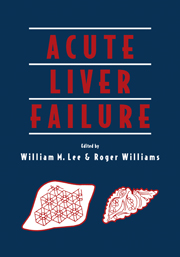Book contents
- Frontmatter
- Contents
- Preface
- Foreword
- Acknowledgments
- Contributors
- Part One Clinical Syndrome and Etiology
- Part Two Mechanisms of Disease and Multisystem Involvement
- Part Three Intensive Care Management
- Part Four Transplantation
- Part Five Artificial and Bioartificial Liver Devices
- Part Six Other Applications
- 21 Treatment of acute liver failure by high volume plasmapheresis
- 22 Dialysis/adsorption techniques for acute liver failure
- 23 Hepatocyte transplantation in liver failure and inherited metabolic disorders
- Index
- Plate section
23 - Hepatocyte transplantation in liver failure and inherited metabolic disorders
from Part Six - Other Applications
Published online by Cambridge University Press: 20 May 2010
- Frontmatter
- Contents
- Preface
- Foreword
- Acknowledgments
- Contributors
- Part One Clinical Syndrome and Etiology
- Part Two Mechanisms of Disease and Multisystem Involvement
- Part Three Intensive Care Management
- Part Four Transplantation
- Part Five Artificial and Bioartificial Liver Devices
- Part Six Other Applications
- 21 Treatment of acute liver failure by high volume plasmapheresis
- 22 Dialysis/adsorption techniques for acute liver failure
- 23 Hepatocyte transplantation in liver failure and inherited metabolic disorders
- Index
- Plate section
Summary
INTRODUCTION
Although orthotopic liver transplantation has markedly improved the prognosis for patients with acute and chronic liver failure or inherited metabolic disorders of the liver, a world wide shortage of donor organs significantly limits the universal use of this procedure. The whole liver can be stored for only 24–48 h, necessitating rapid transport of the organ. The technical and financial resources required for orthotopic liver transplantation will keep routine use of this procedure impractical in many parts of the world for a long time. Transplantation of isolated liver cells could address many of these problems. In many conditions, transplantation of a fraction of hepatocytes derived from a single liver would be sufficient, permitting the use of a single donor organ in the treatment of several patients. Cryopreservation of hepatocytes can make the cells readily available, averting the problem of organ transport. Isolated liver cells have been used also as vehicles for liver-directed ex vivo gene therapy for metabolic liver diseases. Recently, techniques of conditional immortalization of hepatocytes have opened another potential avenue to grow hepatocytes in culture, thereby increasing the availability of the cells for therapeutic use. However, as in whole organ transplantation, immune rejection limits the survival of transplanted hepatocytes, requiring prolonged immunosuppression. Active research is going on in several laboratories for abrogating allograft rejection. Here, we wish to present a brief discussion of critical aspects of hepatocyte transplantation and the work currently in progress.
- Type
- Chapter
- Information
- Acute Liver Failure , pp. 285 - 300Publisher: Cambridge University PressPrint publication year: 1996

